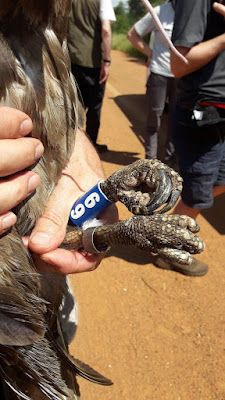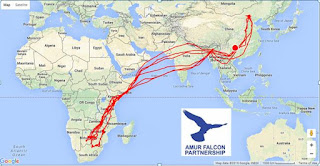During the heat of the day we undertook various drives not only for raptors but to bird or enjoy the country.
Whilst staying at our Ndabushi site this drive took us into the Blyde River Canyon at the foot of the Drakensberg Mountains. This a site for Verraux's Eagle one of the few raptor species which we didn't see but from the bridge we saw an African Finfoot and the sky was full of locally breeding Little Swifts.
An incredible scenic setting...
Wildlife appears everywhere on a trip like this....
We left the airport for our first site Intulo, catching some raptors on the way.
Nets placed in scrub at the site for the morning but the initial target was Little Swifts nesting in the buildings.
Seven Little Swifts were ringed and a Pearl Spotted Owlet obligingly appeared.
Next morning the nets were opened, a couple of spring traps set and a variety of birds were ringed. The following Palearctic migrants were the highlights. Common Whitethroat (a notable species for here) Willow Warbler and Red-backed Shrikes.
Scaly-feathered Finch
We did have interesting results in the evening though with two European Nightjars caught, both appearing to have suspended moult. A third European Nightjar was ringed the following morning, this bird still moulting flight feathers.
Our third location was Kaoxa in the Mpungubwe National Park. Wonderful views from the ringing table out to the Botswana and Zimbabwe borders. Elephants in the distance and Rock Hyraxes on the close rocks. Lions, Hyenas and Jackals calling at night...
The birds caught here were mainly around the swimming pool....
Species here included several Green-winged Ptylia
Brown-hooded Kingfisher, Golden-breasted Bunting, and Greater Blue-eared Starlings.
During the heat of the days two great drives through the bush, several Kori Bustards amongst the Zebras, Wildebeest, Giraffes, Jackals...etc..
Kori Bustard - one of 6 seen on the plain there
Red-billed Oxpeckers
On our first night here, no Nightjars came to the nets, but I managed to pick up this Freckled Nightjar.
Out on a night drive whilst based at Koaxa we had an amazing experience....
We came across a roadside Spotted Eagle Owl and we dropped a trap. Whilst waiting for a response, a Red-crested Korhaan flew and landed on the road. Amazing viewing for the team as I managed to catch the Korhaan, on a noisy underfoot gravel road, whilst keeping their eyes on the Eagle Owl as it arrived on the trap.
A majestic Spotted Eagle Owl,.
On the journey back to the site we did pick up a Cinnamon-breasted Bunting which we roosted overnight before release in the morning.
Kaoxa is also an historical site for cave paintings
After a visit to view the artwork here we are looking at the nesting Rock Martins, Cinnamon-breasted Buntings and the Mocking Cliff Chats.
Our next site was at Zulani, where recent rains had made the surrounding land fertile and full of seeding grasses. A mighty Red-billed Quelea colony was present, at least 10km long along the one side we travelled. This colony was the cause of our next spectacle ! The colony was a feeding ground for a combination of raptors and storks, the main species being Lesser Spotted Eagles, White, Abdim's and Maribou Storks. Birds arriving in the thermal above forming a spectacular kettle.
Every night we cooked on a Brai, fresh steak daily...
.....complemented with Malcolm's famous Veg packs
Last year on a similar timed visit we ringed 16 European Rollers, this visit we only managed two.
How each year and visit differ ! Whilst searching roadside wires for the often 3 species of Roller that are present in the area, we encounter far more Red-backed and Lesser Grey Shrikes.
Zwakala Brewery was our next ringing base and lodge, a craft brewery overlooking the Wolkberg mountains.
Our first visit to higher altitude....a drop in temperature and forest, riverine and cultivation more akin to home in Wales.
Spring traps were valuable here for catching birds like this Cape Robin-Chat
This delightful Swee Waxbill, one of the endemic species of the higher altitude area as were the Forest Canaries and the 2 Barratt's Warblers we captured. The first Barratt's Warbler was a valuable recapture.
Here around our accommodation Wire-tailed Swallow were always present, nesting nearby.
Nyala around the nets....
Here we were able to set some nets in the riverside vegetation. We were hoping for Olive-tree Warbler and Marsh Warbler here. No luck with the Olive-tree Warblers on this visit but we did catch 8 Marsh Warblers. As part of processing we do moult score the primaries of every bird. For both Marsh and Willow Warblers we had birds in active wing moult and birds that had finished their moult.
Interesting race Willow Warblers - both ‘acredula/yukutensis and trochilus sub-species.
African Pygmy Kingfisher
Our final site was Moorfield Farm near Muller's Pass at 1750m. Surrounded by superb Highveld grassland, the land of Cranes, Black Harrier and Secretary Bird.
Cape Batis recapture.
All the sites that where we use mist nets are regular ringing sites for Malcolm, therefore we do recapture a proportion of resident birds. None on this visit but we do recapture site faithful Palearctic wintering birds too eg a Red-backed Shrike on a visit in Feb 2018.
African Thrush
A Highveld speciality - Yellow-throated Woodland Warbler
Many Cape White-eye, the " Blue Tits" of our higher altitude sites
This waterfall was at end of our net rides at this location.
We used Moorfield Farm not only as a ringing site but for accommodation that best suits visits to the Amur Falcon roost in Newcastle, as described in the previous post.
We encountered a great variety of insects on the trip, this Katydid was our favourite and one of the more colourful.
A final mist net session on the way to the airport, the low bridges across the streams often have breeding endemic South African Cliff Swallows.
We caught 28 SA Cliff Swallows and a Malachite Kingfisher here.
Finally the Team photo at 2000m in the Normandien Pass, not far from where we caught the Secretary Bird.
This and the previous post about our experience with Raptors give an insight into our 2 weeks in South Africa. Many thanks to Malcolm Wilson (African Affinity)
(Photos - contributions from all, especially Andrew)






































































